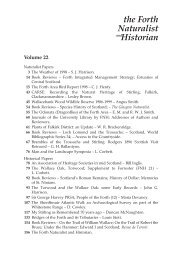fnh journal vol 24 - Forth Naturalist and Historian - University of Stirling
fnh journal vol 24 - Forth Naturalist and Historian - University of Stirling
fnh journal vol 24 - Forth Naturalist and Historian - University of Stirling
You also want an ePaper? Increase the reach of your titles
YUMPU automatically turns print PDFs into web optimized ePapers that Google loves.
50 J.A. Stewart<br />
trapped the most common species was the Tetragnathid Pachygnatha degeeri<br />
with 440 specimens, most <strong>of</strong> which were taken in the drier area at the edge <strong>of</strong><br />
the moss, in heather <strong>and</strong> tufts <strong>of</strong> grass.<br />
A full species list is given in the Appendix.<br />
Acknowledgements<br />
My thanks go to June Waley, Reserve Warden, <strong>and</strong> the Call<strong>and</strong>er Support<br />
Group <strong>of</strong> the SWT for arranging access to the reserve, to Peter Merrett for the<br />
initial identification <strong>of</strong> Heliophanus dampfi, to Bob Saville for identification <strong>of</strong> the<br />
harvestmen, to Richard Bacon for help with the field work, to Isobel Baldwin<br />
for field work <strong>and</strong> help with the preparation <strong>of</strong> this paper, <strong>and</strong> to Tim Benton<br />
for suggesting improvements to the original draft.<br />
References<br />
Nelson, J.M. (1983/4). Some insects from a portion <strong>of</strong> East Fl<strong>and</strong>ers Moss, Central Region.<br />
<strong>Forth</strong> <strong>Naturalist</strong> <strong>and</strong> <strong>Historian</strong> 8, 55-63.<br />
Williams, S.A. (1991). Heliophanus dampfi Schenkel (Salticidae) in mid-Wales <strong>and</strong> new to<br />
Britain. Newsl. Br. arachnol. Soc. 61, 3-4.<br />
APPENDIX – LIST OF SPECIES<br />
(p = trapped in pitfalls, h = collected by h<strong>and</strong>)<br />
Order ARANEAE (Spiders)<br />
Family DICTYNIDAE – small brownish spiders, makers <strong>of</strong> mesh type webs.<br />
Dictyna arundinacea (h) – very common on heather <strong>and</strong> other plants where it<br />
<strong>of</strong>ten spins its web on dry dead heads.<br />
Family GNAPHOSIDAE – mostly nocturnal hunters that spend the day in<br />
silken cells under stones <strong>and</strong> other detritus. They prefer dry sites which<br />
they apparently find quite readily in wet, marshy areas.<br />
Drassodes cupreus (p,h) – up to 15 mm long, <strong>and</strong> uniformly fawn in colour, this<br />
fierce hunter is commonly found in grass clumps <strong>and</strong> under stones.<br />
Haplodrassus signifer (p,h) – a common species found in similar habitats to the<br />
previous one.<br />
Zelotes latreillei (p) – a shiny black spider with a widespread distribution in<br />
Engl<strong>and</strong> but recorded in only a few Scottish vice-counties.<br />
Micaria pulicaria (p,h) – common <strong>and</strong> widely distributed, this spider does not<br />
limit its search for prey to night time, but can be found running about in<br />
bright sunshine. Rather ant-like in appearance with an iridescent abdomen.<br />
Family CLUBIONIDAE – like the previous family the Clubionids are mainly<br />
nocturnal hunters that hide during the day in silken cells in a variety <strong>of</strong><br />
situations.<br />
Clubiona reclusa (h) – a common species in low vegetation in damp or marshy<br />
sites. The female with egg sac is usually found in a curled leaf.



